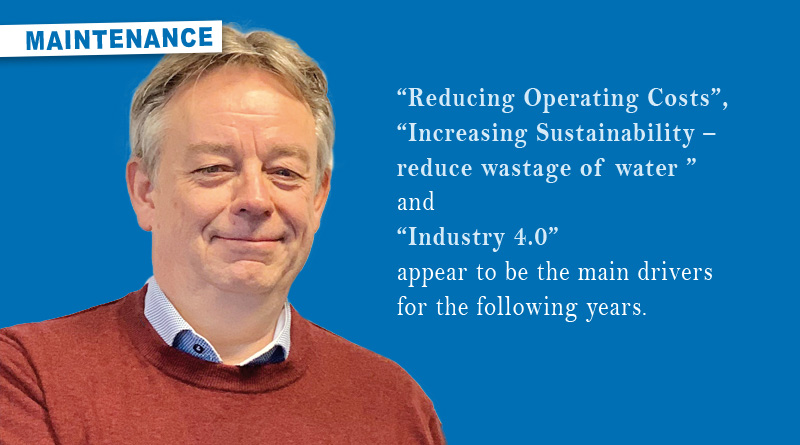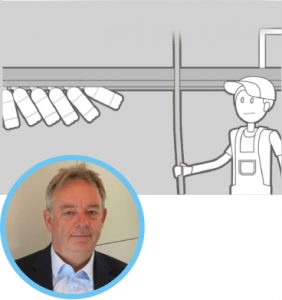Bottle jams never again
by Heike Fischer
CHP engineering company is offering a wide range of lubrication solutions, specific for the food and beverage industries all over the world. CHP’s activities are grouped into four strategic business units: the MicroDry Slat lubrication technology, the MicroDry Air coating technology, the MicroDry all-in-one hygienic solution (CIP) and full service package for installation, maintenance, consumables, parts & accessories.
For the PET industry – which had been a very successful market for the company since 2004 – CHP developed a specific solution to prevent bottle jams for factories working with air conveyors: the MicroDry Air coating technology. Big players within the beverage industry are using CHP’s technology, e.g. Coca-Cola or Nestlé Waters. PETplanet Insider talked with Pieter Turck, Founder, previous CEO of CHP and Executive Director since 1st of January 2020 about accepted problems in the production process that can be easily solved and finally, about their future plans for CHP.
PETplanet: Mr Turck, CHP is now active in the PET industry for more than 15 years. What was the trigger to turn to this branch of industry? What were the challenges and incentives for this step?
Turck: In the first years CHP focused on the cardboard business with MicroDry, mainly on packaging lines supplied by Tetra Pak and SIG Combibloc. Since some of our major accounts also operate PET lines, we were triggered by these customers to use the same technical platform of MicroDry to substantially reduce the operational costs and increase line efficiency on the wet lubricated PET bottling lines. These successes allowed us to gain market share quickly at typical bottling companies as Coca-Cola, Nestlé Waters, etc.
PETplanet: How much is the PET sales share in the CHP Group now?
Turck: The sales of the MicroDry PET Slat, MicroDry PET AIO and MicroDry PET Air contribute for about 81% of the global revenue.
PETplanet: Mr Turck, what do you think are the biggest problems when working with PET containers? Where does CHP technology come in?
Turck: To answer this question, we need to differentiate on PET Slat and PET Air.
PET Slat: Line efficiency has always been a big concern and becomes even more critical for our customers as bottles get lighter, are more frequently composed of recycled plastics or have shapes creating higher instabilities during conveying. The lower, stable and per-conveyor tuneable friction values between bottle and belt surface differentiate MicroDry from the conventional wet and half-dry solutions available on the market. The lower consumption- and maintenance costs and the better hygienic working conditions (safety, hygiene and environment) do create extra value for our customers.
PET Air: More than 80% of the PET air conveyors show bottle jams that have a substantial negative impact on the line efficiency of the bottle-filling machine. Customers often use stand-by manpower to monitor the total line to release the jammed bottle-trains. The MicroDry PET Air solution offers a full automatic coating solution that primarily eliminates those jams and also reduces the operating costs. The pump- and control unit of these solutions can also be used for the PET Slat MicroDry solution. An extra added value when upgrading the filling line after experiencing the many advantages of MicroDry.
PETplanet: Mr Turck would you be so kind to explain CHPs specific MicroDry Air coating technology? What are the specific advantages and what has been improved over the years since launching it?
Turck: In most cases we eliminate all bottle jams. Since launching this solution in 2005, we could help many plant and line managers to eliminate their bottle jams. While installing the MicroDry Air system over the years, the customer also experienced more about all the additional benefits of the system. Once the MicroDry Air system was installed, the responsible manager could lower the fan blowing power and thus report substantial energy savings. As a consequence, the noise level of the air conveyor in operation came down substantially, which increased the quality of the work environment. An important topic in many Health and Safety committees.
PETplanet: Mr Turck, what about implementing the MicroDry Air coating technology into an existing line?
Turck: Based on the many years of experience our engineering team designs and produces in a very efficient way the customised inserts for every lay-out and type of the PET Air conveyor line. The pump- and control unit as well as the distribution system of the coating agent are well designed to meet different customer expectations and can be parameterised for each installation. The total installation time, including commissioning, of a typical PET Air conveyor line of about 150 metres length is maximum one week, from which the line shut-down time is about one day (6 to 10 hrs). A longer line with multiple blow moulders and unscramblers (as are commonly used in the USA) needs more installation time.
The units are mostly used as stand-alone systems: the interference with the available PET conveying control system from the OEM is limited to our recommended reduction of the fan blowing power (fans do supply the air flow in the air duct and are typically positioned every 10 m along the air conveyor). This will result in up to 40% reduction of energy consumption.
PETplanet: Mr Turck, some big players of the food and beverage industry already work with your systems since many years. What has been your benefit of working with them?
Turck: The successes accomplished at the big players facilitate CHP to expand internationally:
the subsidiaries or franchising companies of the big accounts are encouraged to work with CHP
as CHP is gaining recognition in the international market, the reference to the big players facilitates taking the first hurdle in the sales process to more local operating bottling companies.
Improvements on the technology are mostly triggered by feedback of the end users as well as recommendations from the major OEM’s building full-integrated bottling lines.
PETplanet: Mr Turck, where do you see potential market trends for your technology now and in the future?
Turck: “Reducing Operating Costs”, “Increasing Sustainability – reduce wastage of water ” and “Industry 4.0” appear to be the main drivers for the following years. CHP will secure its technical competitive advantage through further continuously focusing on improvements and new developments.
CHP will also strengthen the focus on “unburdening” the customer by offering full-inclusive servicing contracts on our MicroDry systems, starting in Europe.
PETplanet: Mr Turck, due to Covid-19 pandemic a lot of company decisions have to be re-thought. How does CHP deal with this special situation?
Turck: Customers recognise the major benefits of the MicroDry technology that also result in low pay-back times of the accompanied investments; hence Covid-19 tends to delay the decision to invest rather than cancelling the outstanding and planned projects.
PETplanet: Thanks you a lot for your statements.
Visit CHP


